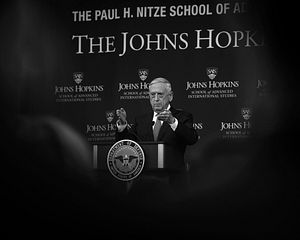On Friday, January 19, the U.S. Department of Defense published an unclassified synopsis (PDF) of the Trump administration’s first National Defense Strategy. (The NDS is the successor to DoD’s older Quadrennial Defense Reviews.) The document is the second in a series of strategy documents released by the administration since December 2017, building on the National Security Strategy. It is also complementary to the leaked draft Nuclear Posture Review document, albeit different in focus.
The 2018 NDS is a remarkable policy document. Speaking at the launch of the document at Johns Hopkins School of Advanced International Studies (SAIS) on Friday, U.S. Secretary of Defense Jim Mattis underlined what makes this NDS important: “Great power competition, not terrorism, is now the primary focus of U.S. national security.” As the U.S. presence in Afghanistan enters its 17th year and operations continue against the Islamic State’s remnants in Iraq and Syria, the NDS is a forward-looking document that presumably looks to cap off America’s post-9/11 fascination with counter-terrorism and recalibrate toward great power adversaries.
For anyone who read the administration’s National Security Strategy (NSS) document, which was released in December 2017, this should be unsurprising. The NDS and the NSS are birds of a feather especially with their interest in China and Russia, which are identified as the primary competitors with the United States. China is identified as a “strategic competitor” before Russia in the NDS, though both are discussed the primary adversaries that United States much prepare to face in the coming years. Aside from these great powers, the NDS, like the NSS, devotes some attention to North Korea and Iran, the “rogue regime” adversaries. Iran is identified as the “single most significant challenge to Middle East stability.”
The NDS does give the Asia-Pacific—or rather the “Indo-Pacific” as is now in vogue—preeminent attention. In discussing the United States’ “enduring coalitions and long-term security partnerships,” the document mentions “Indo-Pacific alliances and partnerships” before the North Atlantic Treaty Organization, giving the Asian region increased importance:
A free and open Indo-Pacific region provides prosperity and security for all. We will strengthen our alliances and partnerships in the Indo-Pacific to a networked security architecture capable of deterring aggression, maintaining stability, and ensuring free access to common domains. With key countries in the region, we will bring together bilateral and multilateral security relationships to preserve the free and open international system.
This language demonstrates a great degree of continuity with the post-2015 push by the Obama administration’s Department of Defense under former Secretary of Defense Ashton Carter to realize a “principled security network” in Asia. The Trump administration has abandoned the idea of the “rebalance,” but has largely retained the logic of Carter’s “principled security network.” Expect to see increased cooperation between the United States and like-minded Asian states—especially Japan, Australia, and India—on matters of regional concern. Strategists in New Delhi, Tokyo, and some in Canberra have been eager to see the United States wake up to the idea of great power contest with China—something this latest NDS is explicit on.
Above all, what stands out about this NDS is how especially un-Trumpian it is. It includes little of the president’s rhetorical hobby horses (no “America First” mentions and just a couple pro forma references to “peace through strength”) and appears to be a product of Mattis’ office of experienced bureaucrats at the Pentagon. In this sense, the document is very much “of the swamp” that Trump and his core supporters decry.
Recall too that we’ll be seeing a classified National Military Strategy document later this year, which will be prepared by General Joe Dunford, the chairman of the Joint Chiefs of Staff. Going from strategy to implementation with this NDS will depend greatly on presidential buy-in. Trump has called for a massive modernization and expansion of the U.S. military, but time will tell how the themes set out in this NDS will translate into reality.

































